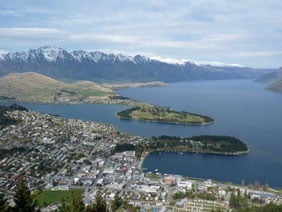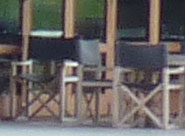Panasonic Lumix DMC-FZ38 / FZ35
-
-
Written by Gordon Laing
Panasonic Lumix DMC-FZ38 / FZ35 lens and stabilisation
The Panasonic Lumix DMC-FZ38 / FZ35’s headline feature is its 18x optical zoom, inherited from its predecessor and delivering an equivalent range of 27-486mm with a focal ratio of f2.8-4.4. The actual focal length is 4.8-86.4mm and like its predecessor it boasts very fine powered zoom increments – we counted over 60 in total. As other manufacturers play an ever-increasing numbers-game on super-zoom ranges, it may be disappointing for some to find Panasonic sticking with the same optics as a previous generation. But the 18x lens of the FZ28 and the new FZ38 / FZ35 is a decent performer which unlike its much longer rivals doesn’t lose too much contrast when zoomed-in, and realistically speaking, there’s few who would actually find its 27-486mm range compositionally restrictive.
 | ||
When powered-up, the barrel extends by 7mm from its housing, with the camera ready for action in just 1.2 seconds – about one third quicker than the FZ28. As the camera zooms-in, the barrel steadily extends to 25mm from its housing and you can see how this looks in the photo below, which from top to bottom shows the FZ38 / FZ35 switched off, switched on, then fully zoomed-in.
 |
There’s two different speeds for the zoom depending on how far you push the rocker control, and the slower of the two is sufficiently quiet for Panasonic to allow it while filming video – and you can see examples in our FZ38 / FZ35 video compilation.
The lens cap works the same way as its predecessor: a substantial disc which clips onto the outer section of the lens housing. This means the cap will block the inner barrel from extending during power-up, at which point the camera asks you to remove the cap, then press any key to proceed. It’s not quite as convenient as the cap on the Canon SX20 IS which clips to the extending portion of its lens, although again it is more substantial like a DSLR lens cap.
Panasonic supplies the FZ38 / FZ35 with an equally substantial lens hood which adds 65mm to the length of the camera, more than doubling the length of the lens housing. The hood consists of two parts: a plastic ring which screws into the end of the outer lens housing, and the main hood itself which clips onto the ring and freely rotates until you turn a thumbscrew to lock it into position. Once locked-in place, it’s fairly easy to unscrew the hood and screw it back on again without having to adjust the rotation.
By not clipping into position though, the FZ38 / FZ35 once again runs the risk of not having its hood orientated correctly and causing vignetting at wide angle as a consequence. We’ve actually seen several people making this mistake with its predecessor, so it’s worth watching out for. Panasonic sticks a notice on the hood warning it should be used in the correct position, but it would be easier if it just clicked into place like most DSLR lens hoods – or indeed that of its main rival, the Canon SX20 IS.
It should also be noted that unlike the Canon, the FZ38 / FZ35’s lens hood is too large to be reversed over the lens housing for transportation, so it’ll be another item to carry around and possibly lose. While it’s tempting to leave it at home though, we’d recommend taking it with you as on several occasions our FZ38 / FZ35 suffered from flare due to stray sunlight.
The closest focusing distance in macro mode is just 1cm, which may not match the zero cm distance of the Canon SX20 IS, but in practical terms both cameras can get extremely close to their subjects. At such close range though, it’s hard not to cast shadows, and the images can also suffer from pronounced geometric distortion and softening in the corners. We found we could essentially match the same reproduction by moving back a few cm and zooming the lens to approximately two-times, at which point the field became much flatter and less distorted, with fewer lighting problems too. You can see an example in our FZ38 / FZ35 Gallery.
The most impressive aspect of the FZ38 / FZ35’s lens though is of course its optical zoom range, which takes you from decent wide-angle to super-telephoto coverage. As mentioned above, it may now seem relatively ‘short’ compared to the longest of its rivals, like the 26x of the Olympus SP-590UZ, but it remains a considerable range to have at your disposal which should cover most situations.
To illustrate the FZ38 / FZ35’s coverage we mounted it on a tripod and shot the same scene fully zoomed-out, then fully zoomed-in. We then shot the same scene from the same position using its arch rival, the Canon PowerShot SX20 IS which is equipped a slightly longer 20x zoom with an equivalent range of 28-560mm.
|
Panasonic Lumix FZ38 / FZ35 coverage wide |
Canon PowerShot SX20 IS coverage wide | |
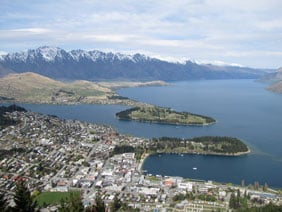 | ||
4.8-86.4mm at 4.8mm (27mm equivalent) |
5-100mm at 5mm (28mm equivalent) |
Above you can see examples of both cameras fully zoomed out. Panasonic quotes the FZ38 / FZ35 as having 27mm equivalent coverage to the SX20 IS’s 28mm, but as you can see here they’re essentially delivering identical fields of view. But the important thing is they’re both offering true wide angle coverage.
Panasonic Lumix FZ38 / FZ35 coverage tele |
Canon PowerShot SX20 IS coverage tele | |
 |  | |
4.8-86.4mm at 86.4mm (486mm equivalent) |
5-100mm at 100mm (560mm equivalent) |
Above are examples taken with each camera fully zoomed-into their maximum focal lengths. The 560mm equivalent of the Canon SX20 IS is clearly capturing a tighter field of view than the 486mm of the Panasonic FZ38 / FZ35, but in practice it may not look as much as the 74mm difference implies when written down.
So while the SX20 IS beats the Panasonic in terms of overall coverage, the examples above illustrate there’s not a great deal in it – certainly we wouldn’t choose the SX20 IS over the FZ38 / FZ35 based on range alone. Both cameras sport extremely broad zoom ranges which offer amazing opportunities in practice, and you can see some examples of how you might use them in our Gallery. To see how the quality of each compares when fully zoomed-in, check out our first Results page.
If the extra reach of the Canon sounds tempting, but you prefer the Panasonic, then you may be interested in the optional DMW-LT55 lens converter which multiplies the range by 1.7 times to deliver a maximum equivalent focal length of 826mm. Alternatively the optional DMW-LC55 improves the camera’s close-up capabilities.
Both converters mount onto the FZ38 / FZ35 via the optional DMW-LA3 lens adapter which screws onto the end of the main lens housing; like other lens converters, they’ll significantly increase the size and weight of the camera, but at least the option’s there.
You can also screw filters into the end of the extending lens barrel. Panasonic offers the DMW-LMC46 transparent filter, DMW-LND46 Neutral Density filter (3 stop reduction) or the DMW-LPL46 polarizer. The thread measures 46mm, but we didn’t try it with third-party filters.
Finally, a quick note on aperture. The FZ38 / FZ35 has a focal ratio of f2.8~4.4, compared to f2.8~5.7 on the SX20 IS. While the Canon is optically slower when zoomed-in, due in part to its longer focal length, it’s useful to compare the points in the range where the maximum aperture changes.
The FZ38 / FZ35 only offers its brightest f2.8 aperture between 28 and 34mm. F3.0 kicks-in between 34 and 48mm, followed by f3.2 between 48 and 65mm. Next comes f3.4 between 65 and 98mm, followed by f3.6 between 98 and 155mm. After this comes f3.7 which operates between a longer range of 155 and 414mm, followed by f3.8 between 414 and 452mm. F4.0 kicks-in at 452mm up to 461mm, after which it’s f4.4 up to the maximum equivalent focal length of 486mm.
It’s revealing to compare portions of this range with the SX20 IS. For example between 155 and 414mm, the FZ38 / FZ35 offers a maximum aperture of f3.7, while the SX20 IS operates approximately one stop slower with a maximum of f5.0 between 168 and 560mm. Since the SX20 IS operates at f5.7 for the final 100mm of its range, the FZ38 / FZ35 is around 2/3 of a stop faster when both are set to the Panasonic’s longest focal length of 486mm. So the FZ38 / FZ35 definitely has light-gathering advantages over its rival, although as seen in our results and gallery pages, its Program line does have a habit of selecting smaller apertures rather than quicker shutter speeds under bright conditions.
Panasonic Lumix DMC-FZ38 / FZ35 image stabilisation
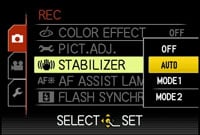 |
Like all Lumix compacts, the Panasonic Lumix FZ38 / FZ35 features optical image stabilisation (OIS) which adjusts a lens to counteract for camera shake. Panasonic does however claim it’s now twice as effective as the earlier FZ28, and as such has renamed it from Mega OIS to Power OIS.
Like its predecessor though, there’s still the same options: Mode 1 applies stabilisation constantly, while Mode 2 only applies the stabilisation as you take the picture. An additional Auto option switches between Mode 2 when zoomed-out and Mode 1 when zoomed-in.
Mode 2 has the potential to be more effective since the system always starts from a central position, although the downside is not seeing the reassuring stabilised effect as you compose the image – that’s why the Auto mode sensibly opts for Mode 1 when zoomed-in as while it may not potentially be as effective, at least you can easily frame your shot. Note OIS is also available when recording movies, but only in Mode 1.
| ||||||||||||||||
Alongside are 100% crops from images taken with the FZ38 / FZ35 zoomed-into its maximum equivalent focal length of 486mm, where traditional photographic advice would recommend a shutter speed of around 1/500 to avoid camera shake.
The examples were taken at a much slower shutter speed of 1/30, and unsurprisingly the first, without stabilisation, is very shaky; indeed we required the recommended 1/500 exposure for a completely sharp result. The two samples taken with stabilisation enabled are however almost 100% sharp, although interestingly Mode 1 has proven more effective of the two here – while also providing a reassuringly steady view while composing.
So in the tests above, Mode 1 delivered four stops of compensation over both traditional wisdom and what we actually needed without stabilisation; this makes it one stop more effective than the earlier FZ28 in our tests, confirming Panasonic’s claims of improvement.
It’s certainly a very impressive system in use, delivering a reassuringly stabilised view as you compose at high magnification, and ensuring the final image is shake-free at relatively slow shutter speeds. We also found the stabilisation very effective when filming videos, although as usual, panning quickly can cause the system to jerk a little.
Panasonic Lumix DMC-FZ38 / FZ35 focusing
 | ||
The Panasonic Lumix FZ38 / FZ35 offers a wide variety of AF modes and the company claims AF speed is now twice as fast as its predecessor. In terms of AF modes, there’s Face Detection, AF Tracking (which follows a subject of your choice), Multi-area (which uses either the full 11 areas or one of five zoned groups to lock onto subjects across the frame), Single-Area High Speed (which quickly focuses on the subject in the centre of the frame), Single-Area (which does the same but more slowly), and Spot focusing (which further narrows the active area in the middle). These modes allow you to choose a balance between the number of focusing areas and the speed of operation – handy for times when you need quicker response, but from more predictable areas.
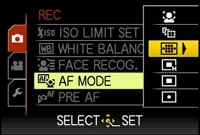 |
The FZ38 / FZ35 also offers Pre-AF options which can be set to either focus continuously, or focus when the camera detects minimal shake, allowing even quicker response when you half-press the shutter release. Continuous AF is also available in the movie mode, and necessary if you’re zooming the lens or want a subject in motion to remain sharp.
The AF Tracking option shows a cross-hair in the middle of the screen which should be placed over the target subject by pointing the camera at it. Then when you’re ready, press the AF / AE lock button and once the FZ38 / FZ35 locks onto the subject it’ll track it quite effectively around the frame or as it changes distance – once running, it works a little like face detection, but for any kind of object.
Speaking of face detection, the FZ38 / FZ35 will indicate the primary subject with a green frame, automatically adjusting the focus and exposure as required; additional faces are indicated by white frames. Like its predecessor, the FZ38 / FZ35’s face detection worked well under a variety of conditions and also locked-onto subjects even when they were almost in full profile. It’s activated automatically in the Portrait scene presets or when the Intelligent Auto mode spots a person. Alternatively you can manually select it from the Q.Menu or the main menu system when shooting in any other mode if desired.
Panasonic’s made bold claims about doubling the speed of the AF over its predecessor, and while we don’t have side-by-side timings to confirm the actual figures, it certainly felt noticeably quicker in general use. Whether zoomed-out or zoomed-in, the FZ38 / FZ35 snapped most subjects into focus almost immediately, which in turn benefitted all the AF modes including face detection. In side-by-side tests, the AF also felt fractionally quicker than Canon’s SX20 IS.
The Pre AF mode helps by starting the AF process before you even press the shutter release button, allowing the camera to focus on the primary subject while you’re framing the shot. This is of course no different to existing (and power-hungry) continuous shooting modes, but the clever part about Panasonic’s system is the default Q-AF option only starts the AF process when you’re actually lining-up your shot, by measuring reduced wobbling. This in turn gives you the speed advantage of continuous shooting, without the constant power drain.
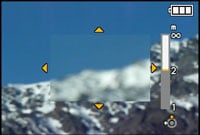 |
Pushing the AF / Macro / MF button on the top of the camera allows you to switch between normal AF, two Macro modes and manual focusing. With MF selected, you can push the joystick up and down to adjust the focusing distance; this is indicated on-screen by a scale with a yellow bar representing the depth of field at the current aperture.
While manually focusing, the FZ38 / FZ35 can display an enlarged portion for assistance; a menu option allows this enlarged area to either occupy a window in the middle of the screen, or temporarily fill it entirely. You can also adjust the position of the area to be enlarged if required.
Panasonic Lumix DMC-FZ38 / FZ35 sensor and processing
The Lumix FZ38 / FZ35 is equipped with an 12.1 Megapixel CCD sensor, which measures 1 /2.33in and generates images with a native 4:3 aspect ratio and a maximum resolution of 4000×3000 pixels. As before, there’s the choice of five lower resolutions, along with cropped 3:2 or 16:9 modes, each in the choice of four resolutions. Images can be recorded in Fine or Standard JPEG quality, or as a RAW file; alternatively you can record a RAW file and a Fine JPEG together. Note continuous shooting is disabled when RAW is selected.
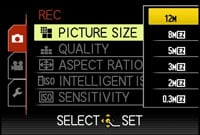 |
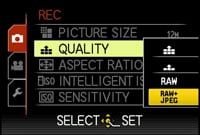 |
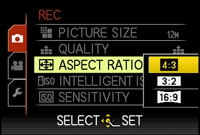 |
RAW recording is a key advantage the FZ38 / FZ35 continues to have over its arch rival from Canon. In Canon’s ‘wisdom’, the only non-DSLRs in its range with RAW facilities are the PowerShot G11 and SX1 IS, so this somewhat limited approach allows other manufacturers to take a lead in this respect. Panasonic supplies SilkyPix software for converting RAW files and you can see examples compared to in-camera JPEGs in our results pages.
The FZ38 / FZ35’s sensor gives the camera two extra Megapixels over its predecessor, allowing prints to be made at 13.3x10in at 300 dpi – that’s an extra inch taller than before. The sensor is however the same size as before, so the pixels are packed-in more tightly leading to concerns over noise – see our results pages for a full report, although note Canon’s PowerShot SX20 IS also employs a 12.1 Megapixel / 1/ 2.3in sensor.
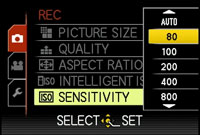 | 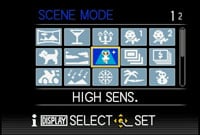 |
Best quality 12M Fine JPEGs typically measure between 4.5 and 6MB each, while RAW files measure around 14MB each; Panasonic has equipped the FZ38 / FZ35 with 40MB of internal memory to get you started – that’s 10MB less than the FZ28, but in either case, you’ll still want to fit a nice big SD card sooner rather than later. The sensor resolution of the SX20 IS is identical, but to see how their resolving power compared in practice, see our results pages.
The sensitivity at full resolution runs from 80 to 1600 ISO, while the High Sensitivity preset operates at 1600, 3200 or 6400 ISO depending on the conditions, albeit at a greatly reduced resolution of 3 Megapixels and with significant image processing. You can see samples using the complete range of full resolution sensitivities on our FZ38 / FZ35 High ISO Noise results page.
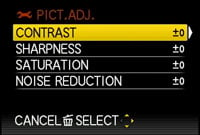 | 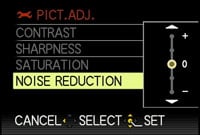 |
Contrast, Sharpness, Saturation and Noise Reduction are applied using the same Picture Adjustments menu as before – Panasonic’s resisted the temptation to equip the FZ38 / FZ35 with the Film Modes of the LX3 and GH1. So like the FZ28, you have five settings for each on a scale of -2 to +2. Zero is selected by default for each, and like the FZ28, this will produce consumer-friendly photos out of the camera, although as you’ll see in our Results and Gallery pages, there’s visible noise artefacts from 200 ISO upwards.
There’s also a selection of colour effects to choose from: off, black and white, sepia, cool and warm. Along with a variety of white balance presets are two custom modes and the ability to enter a colour temperature via an on-screen scale; there’s also white balance adjustment options.
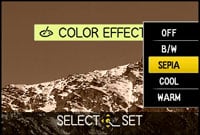 | 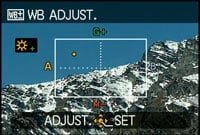 |
Intelligent Exposure (which can adjust the contrast to balance scenes with extremes of brightness) can be applied manually with the choice of three levels, although we didn’t notice any difference with our standard indoor Church shot containing dark shadowy ceilings and brightly backlit windows.
There is at least one image processing trick performed by the FZ38 / FZ35 though that’s very effective. One glance at our first results page reveals images completely bereft of coloured fringing, which look very impressive alongside those from the Canon SX20 IS. The lack of fringing isn’t down to superior optics though, but in-camera correction to JPEGs. If you examine RAW files with correction disabled, you can see the FZ38 / FZ35 suffers from coloured fringing to roughly the same degree as the Canon SX20 IS. So while the FZ38 / FZ35’s optics aren’t better-corrected than the SX20 IS in this respect, the in-camera correction (like its predecessor) does a great job – shame Canon didn’t include a similar facility on the SX20 IS, and of course its lack of RAW files limits your options. PS – there’s also a new High Dynamic scene preset which we’ve covered in the Design page.
| ||||||||||
Panasonic Lumix DMC-FZ38 / FZ35 movie mode
The FZ38 / FZ35 features 720p HD video recording like its predecessor, but now adds manual control over exposures, stereo sound, a dedicated record button and the choice of encoding formats. As before you can optically zoom while filming, but you still can’t take photos without stopping the recording.
The earlier Lumix FZ28 exclusively recorded its video in the Motion JPEG format. Now following the TZ7 / ZS3 compact, the FZ38 / FZ35 offers the choice of encoding 720p HD movies in either Motion JPEG or ‘AVCHD Lite’ – the latter is the same as the AVCHD format employed by most HD camcorders, but only operating at 720p.
With the camera set to Motion JPEG, you have the same four quality choices as before: HD (1280×720 / 16:9), WVGA (848×480 / 16:9), VGA (640×480 / 4:3) and QVGA (320×240 / 4:3), all recorded at 30fps.
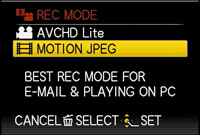 | 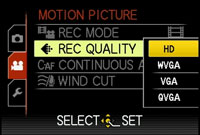 |
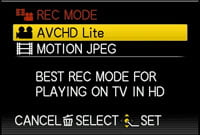 | 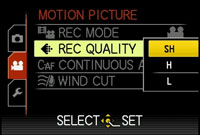 |
Switch to AVCHD Lite mode and the resolution is fixed at 720p (1280×720 / 16:9), but with the choice of three compression settings: SH (17Mbit/s), H (13Mbit/s) or L (9Mbit/s). If you have a ‘PAL’ model (Europe / Aus / NZ), the sensor outputs 25fps and the AVCHD files are recorded at 50p. If you have an ‘NTSC’ model (North America), the sensor outputs 30fps and the AVCHD files are recorded at 60p.
Keeping the old format as an option alongside the new seems a little odd at first, especially with rivals like Canon making a wholesale switch from Motion JPEG to H.264 with its latest DIGIC 4 models. But Panasonic argues both formats have their advantages: AVCHD is more efficient, extending recording times in the same memory, while compatible Viera TVs can also play content directly from SD cards. In contrast, Motion JPEG may consume your memory card quicker, but it’s much quicker and easier to play, edit or recompress on your computer.
To put them in perspective, we filmed the same 46 second sequence moments apart with both formats, with the 17Mbit AVCHD Lite and Motion JPEG versions measuring around 72MB and 172MB respectively, despite delivering roughly the same image quality. We then imported both clips into Adobe Premiere Pro CS4, and confirmed the Motion JPEG version was much more responsive when scrubbing or editing than the one using AVCHD.
There is however another key advantage to using AVCHD beyond smaller files. Motion JPEG files on the FZ38 / FZ35 are restricted to 2GB in size, which limits HD recording to about 8 minutes and 20 seconds. In contrast, switching to the AVCHD Lite mode allows you to keep recording uninterrupted until you run out of memory. Fit an 8GB card and you could record for an hour in the best quality setting.
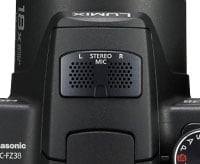 |
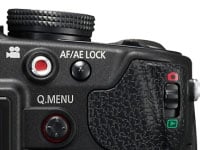 |
We confirmed this by using the FZ38 / FZ35 as a backup camera during an interview with professional photographer Chase Jarvis. Set to the best quality SH mode in AVCHD Lite, the camera happily recorded continuously for 45 minutes without issue. Once the file reaches 4GB in size, another begins, but during playback, there is no interruption. As a sidenote, to make editing of this file easier, we recaptured the recording in Motion JPEG over HDMI using a Black Magic Intensity Pro card. Impressively even after recording for 45 minutes and then replaying the entire file in real-time, the battery still reported two-thirds charge remaining.
There is however one important caveat for the European Lumix FZ38 version, which has a maximum recording time of 29 minutes and 59 seconds per file to comply with tax regulations. But that’s still much longer than the 8 minute maximum of Motion JPEG.
Another difference worth noting between the two formats is their location on the card itself. Motion JPEG ‘MOV’ files may be found alongside your still photos in the DCIM folder, but the AVCHD ‘MTS’ files are buried away in various nested folders which start with one unhelpfully labelled PRIVATE on your card. This is to ensure compatibility with Panasonic’s TVs, and to play them on your computer, simply point your software at this folder and it’ll work out the rest; we had no issues playing back in Cyberlink’s PowerDVD 8 which ‘saw’ them as a Blu-Ray disc, or opening them directly into VLC Player. Either way, just remember to copy the MTS files out of this folder before reformatting your card.
One final note on MTS – it may be standard for Panasonic’s AVCHD cameras, but many programs and services are not compatible. For example at the time of writing, Vimeo wouldn’t accept MTS files in their native format. So if you intend to edit AVCHD footage from the FZ38 / FZ35, ensure your software is either natively compatible with MTS files, or you have some means to convert or recapture them first – or simply record in Motion JPEG instead. We used Adobe Premiere Pro CS4 to natively edit the MTS files for our video compilation; the file below was recorded in Motion JPEG for compatibility with Vimeo.
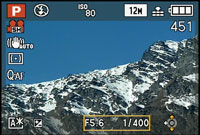 |
As mentioned at the start, the FZ38 / FZ35 now also boasts stereo microphones and (following Canon’s super-zooms) a new dedicated record button on the rear, which conveniently allows you to start shooting video regardless of your current mode.
16:9 framing guides (which dim the portions above and below the active area) can be enabled for video, but if they’re disabled, then you’ll have to start filming before you’ll see exactly what area’s being captured.
The exception is when you turn the dial to the new Creative Movie mode. This automatically blacks out the top and bottom of the screen (for 16:9 framing), but more importantly then asks if you’d like to shoot in Program, Aperture, Shutter Priority or full Manual. That’s right, like the Lumix GH1, the FZ38 / FZ35 lets you set the aperture and shutter speed for video, although like that camera, you’ll need to choose the mode on-screen rather than with the main dial.
 |
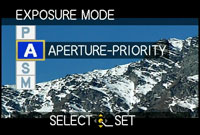 |
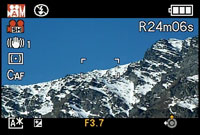 |
Manual control over exposures for video is a key advantage the FZ38 / FZ35 has over the Canon PowerShot SX20 IS, but it comes with the same caveats as shooting stills with. Cameras with small sensors and short actual focal lengths have an inherently large depth-of-field, making it hard to throw the background out of focus even with the smallest f-number. This equally applies for video, so even though the FZ38 / FZ35 will let you adjust the f-number, don’t expect miracles. As with stills, you’ll need to either really zoom the lens in, or get very close to your subject to achieve any blurring effect. That said, we’re still pleased Panasonic included the facility here, as if nothing else, it lets you grossly under or over-expose if desired.
In terms of image quality, both the AVCHD and Motion JPEG modes start with the same raw data stream, and end up recording roughly the same degree of detail.
Both are fairly clean and noise-free under good light, but quite heavily processed with arguably more sharpening and contrast than necessary – but in an opposite turn from the TZ7 / ZS3, it’s the AVCHD Lite mode that’s the slightly softer and more restrained of the two here. The clip shown here was recorded in Motion JPEG for compatibility with our video host, Vimeo, and registered members can download the original file for closer examination here. You can download a clip taken moments apart with the Canon PowerShot SX20 IS for comparison here.
In our tests, the FZ38 / FZ35 managed to stay focused during video sequences without many issues, and only searched briefly when zooming all the way in or out. So all-in-all, a good innings from the latest Panasonic, although as always, if video is your number one priority, a dedicated HD camcorder will be a superior choice.
Panasonic Lumix DMC-FZ38 / FZ35 drive modes
The Panasonic Lumix FZ38 / FZ35 offers two different continuous shooting options. First is the normal burst mode available by pressing the Burst / Trash button in the bottom right corner of the body. This can capture up to three fine or five standard quality JPEG images at a rate of approximately 2.3fps. Note the earlier ‘unlimited’ option of the FZ28 which fired at a slower rate until you ran out of memory is no longer available, and like that model, there’s also no continuous shooting in RAW.
With the FZ38 / FZ35 set to 12M Fine mode and equipped with a Lexar Professional 8GB SDHC card, we fired-off three Fine frames in 1.2 seconds, corresponding to 2.5fps.
 | 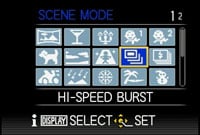 |
The second continuous shooting option employs the High Speed Burst scene preset which reduces the resolution to 3, 2.5 or 2 Megapixels (at 4:3, 3:2 and 16:9 aspect ratios respectively) and the compression to Standard, but allows you to shoot up to 100 images at approximately 6fps (in Image Priority), or 10fps (in Speed Priority); note higher sensitivities of typically 800 ISO are used in this mode. In Speed Priority, we fired-off 44 shots in five seconds, corresponding to a rate of 8.8ps.
 |
The normal Burst and High Speed Burst preset modes both involve compromises, either in total frames or resolution respectively, but are arguably more useful alternatives to the infinite, but slow continuous rate of the Canon SX20 IS which plods along at a useless 1fps. Unlike the FZ38 / FZ35, there’s no option to accelerate the rate whether limiting the number of shots or reducing the quality. So while the FZ38 / FZ35’s burst modes are compromised, they are more useful for capturing action than the SX20 IS.
Finally in terms of self-timer, the FZ38 / FZ35 offers the usual 2 or 10 second modes, along with an option which fires three frames after 10 seconds. Here the Canon SX20 IS out-gadgets it with its custom self-timer and face self timer modes, the latter cleverly exploiting face detection to wait for a new person to enter the frame before starting the countdown.
Now let’s check out how the quality of the Panasonic FZ38 / FZ35 compares against the Canon SX20 IS and a 12 Megapixel DSLR in our results pages.
